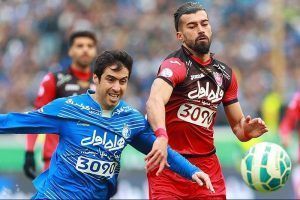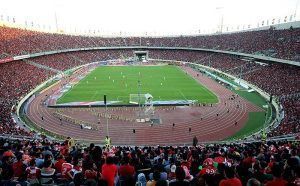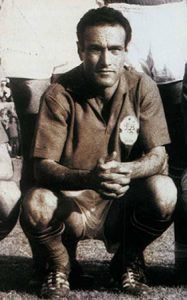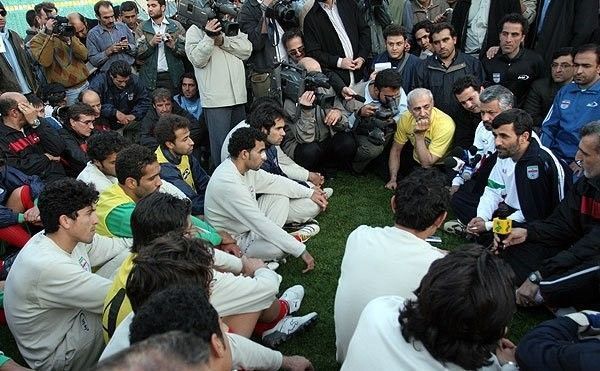By Reza Parchizadeh
[Reza Parchizadeh is a commentator on Iranian affairs. The opinions expressed are his own.]
The Islamic Republic did not pay much attention to football or sports in general in the period immediately following the 1979 Revolution. Over the years, however, football has become not only a profitable industry with a massive fan base in Iran but also a political tool for the regime to reshape and control Iranian culture and society.
In fact, football has overshadowed all other cultural activities in the past two decades. The 24/7 broadcast of football matches and related events is a deliberate attempt by the regime to manipulate Iranian society.
Football has become a weapon of choice for the regime to control public opinion, because it is more open to political influence and also costs less compared to other cultural endeavors such as film. Football is a male-dominated sport which fits well within the Iranian establishment’s patriarchal setup. The authorities don’t have to enforce too many stringent security measures at the games, except perhaps cautioning men who don’t observe the strict Islamic dress code. The authorities don’t have to deal with female football fans because until recently they were not allowed into sports stadiums.
Football was not initially part of the regime’s domestic policy. Quite the contrary: the authorities tried to prevent the formation of a strong fan base for any sport. The ultra-conservatives and the Islamic ideologues considered football as another form of Western influence. A statement by the Bushehr City Council demonstrates this deep-seated hostility towards football.
The statement said: “Isn’t the money better spent on sending our youths abroad to study and gain technical skills rather than on meaningless recreational activities? Isn’t it better to spend public funding on building schools and hospitals and to provide power and clean water to rural areas? Doesn’t it make more sense to help our brothers in the Construction Jihad who help the disadvantaged in remote areas of the country instead of trying to shine on the international stage by engaging in ridiculous games with the U.S. and Britain? Have we solved all of our social, cultural and economic problems so that we can spend time on sports?”
Authorities feared any large gathering of people, let alone that of emotionally-charged football fans. They restricted or completely shut down many public venues that attracted large crowd including concert halls, clubs, and cafes. Conversely, they opened centers that promoted the doctrine of the Islamic Republic, including mosques. They couldn’t, however, close down sports stadiums. Football stadiums were the only places where a large crowd of men could gather and shout, cheer and express their emotions with relative freedom. So, In effect, football stadiums became unofficial symbols of civil resistance.

Date13 February 2017, Source: Wikimedia Commons
The authorities used many tactics to prevent football from becoming a national passion. They didn’t target professional football, which would have attracted unwanted attention. Instead, most city councils around the country prevented the creation of parks or public places that included football pitches for young people to use. The Ministry of Education refused to promote sports, particularly football. They discouraged students from playing football in the schoolyard. So most young people would play outside on the pavement using any object as goal post.. In time, “small goal post” became synonymous with civil resistance.
The regime also made it difficult for fans to attend league games and professional football matches. For instance, the authorities moved the venue for the games from Shahid Shiroudi Stadium (formerly Amjadiyeh) which is in the center of Tehran to Azadi Stadium (formerly Aryamehr) on the outskirts of the city. They rarely allowed live TV broadcasts of games. Most people had to listen to the matches on the radio.

The only sports program worth watching on state TV (IRIB) in the 1980s was entitled “Sports and People.” It was produced and presented by Bahram Shafi. It included a 20-minute round-up of matches from around the world. TV audiences had to wait a week for the next report. It was more of a light entertainment show than a substantive program about the state of sports in the country.
During the 1980s, there were no TV equivalents of the weekly football show “Navad” (meaning ninety – broadcast on IRTV3.) Kayhan Varzeshi (sport) was the only viable source of sports news. Despite its affiliation with the hardline Tehran-based Kayhan daily, the magazine adopted a favorable view of football. Many veteran sportswriters worked for the magazine.
Football provided a conduit to channel civil disobedience in the 80s. But it wasn’t an ideal tool. Quite the opposite, it was rough and dirty. Professional football reflected the prevailing culture of street thuggery and religious extremism. The two phenomena were intrinsically fused together at the time. The regime exerted great influence and control over the football league and the teams including the most popular Tehran’s Persepolis and Esteqlal (formerly Taj.)
It was ultimately Persepolis that came to embody all that was horrible about Iranian football. The coalition of the Iranian Hezbollah and street thugs led by Mojtaba Moharrami and Morteza Kermani Moqaddam, respectively, controlled professional football in the 80s. Under the guise of “revolution and values,” the gang controlled the games through bullying and intimidation. During this period, Persepolis was a dominant team. It set the standard for Iranian football and enjoyed a huge fan base among the working class.

It was during this time that Parviz Dehdari (1935-92) was appointed as the head coach of the Iranian national football team on the recommendation of the late Ahmad Khomeini (1946-95.)
Mr. Khomeini had met Mr. Dehdari years earlier when the latter was a member of the Shahin football team. Dehdari was a principled man. He wasn’t intimidated by those who were running the show.
Dehdari tried to restore what in his opinion was an inherent dignity to the sport. However, professional football is all about entertainment, fans, and money. For instance, during the preliminary games of the 1990 FIFA World Cup, Dehdari pulled one of his players out of a friendly match with Nepal for unsportsmanlike conduct. Many fans, however, didn’t approve of him benching one of the stars of the Iranian national football team and heckled him during a friendly match with Japan at the Azadi Stadium. Football fans didn’t care about ethics, only about results.
Following the 1986 Asian games, five members of the Iran national football team quit in protest. The move didn’t bother Dehdari who immediately set out to form a national football team which included players from all around the country. Up to that point, most players were selected for the national team either from Persepolis or Esteqlal, with only a few from the provincial teams. He recruited young promising talents from around the country, many of whom became exceptional players. Dehdari’s team secured third place in the 1988 Qatar games. The same team won its first major international title at the 1990 Asian Cup in Beijing, with Ali Parvin (1946-) as its head coach.
Dehdari’s untimely death marked the end of an era in Iranian football. He wasn’t alone in his efforts to bring dignity and respect back to the game, but he occupies a special place in the development of the Iranian national football team. In the last few decades, the regime has methodically and systematically gained control over every aspect of Iranian life including sports. Football has lost its power as a tool for civil resistance.
But the regime remains fearful of the potential role that football can play in unifying the people. The recent nationwide unrest galvanized people against the government, the reformists, the conservatives and the regime itself. Football could regain its role as a force to unify the public against the regime. The 2018 FIFA World Cup could trigger another wave of civil unrest.
[Translated from Persian by Fardine Hamidi]


